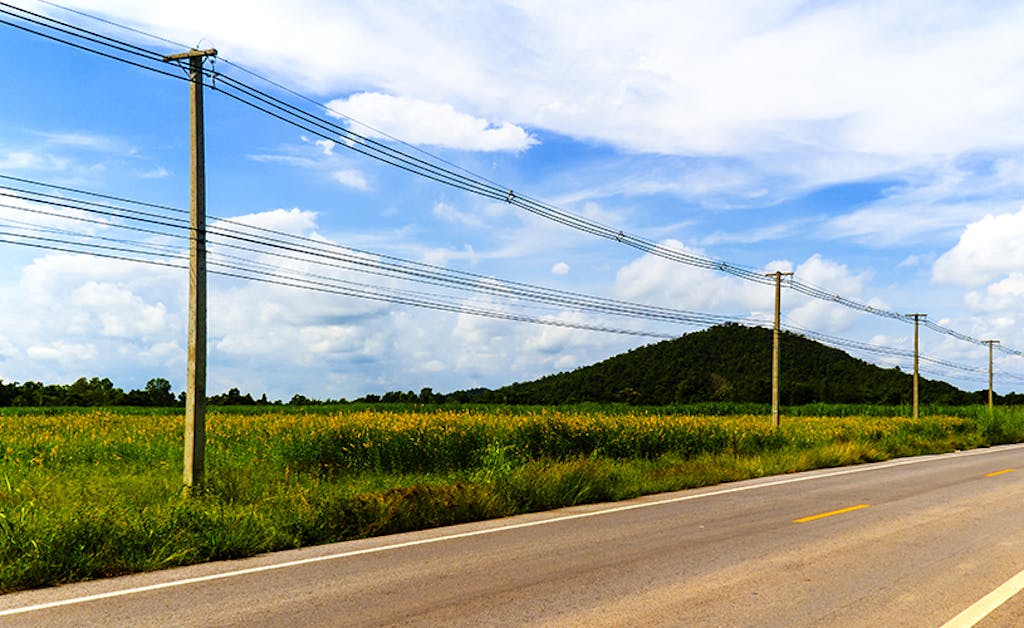9-minute read
In this article:
- Discover what a day in the life of a drone operator entails.
- See what equipment, experience, and certifications are required.
- Learn how pilots prepare for and execute a mission.
There are over 180 million utility poles in the United States, many of which are decades old. To keep them safe and operational, these aging structures must be regularly surveyed and inspected.
But utility poles can be situated in areas with impassable terrain, line of sight issues, or harsh vegetation making them difficult to inspect by vehicle or on foot.
Utility pole inspections also have possible hazards that need to be accounted for. It requires skill and incredible attention to detail to maintain safety when working near electrical assets.

Fortunately, challenges that come with traditional methods of inspection, such as battling through dense vegetation or dangerous terrain, can be mitigated by using drones to inspect power lines.
When drone technology is added to tried-and-true processes, the utility pole inspection can be much faster and more effective. Drones provide teams the ability to view aerial assets and capture images from the best vantage point at a safe distance.
However, using drones for utility pole inspections brings its own risks. Drone pilots must have the right equipment, significant experience, be properly licensed, and have a keen understanding of the mission.
Based on our expertise in this field, here’s what a day in the life of a drone pilot inspection team looks like.
What a Drone Pilot Does
For each inspection, there is a pair of drone pilots assigned to the inspection. Operating uncrewed aircraft systems (UAS) can cause fatigue and drone operators coordinate to account for long hours.
At a minimum, a utility pole drone pilot will capture imagery of a vast number of poles, crossarms, braces, ground-wires, insulators, pins, nuts, tie-wires, transformers, fuses, switches, lightning arresters, and conductors.
The Right Licenses, Certifications and Technologies are Musts
Part 107 Drone License
In addition to the right technology, drone operators must obtain a Part 107 drone license (also known as a Remote Pilot Certificate) from the Federal Aviation Administration (FAA). Obtaining a Part 107 drone license requires weeks of training, passing a 60-question, 2-hour exam, and license renewal every two years.
The exam and training include demonstrating thorough understanding of key topics including FAA laws, the National Airspace System (NAS), weather and micro meteorology, radio communications, and more.
All of Clearsight’s drone operators are Part 107 certified, demonstrating that they have completed rigorous internal training and re-training and understand the regulations, operating requirements, and procedures for safely flying drones.
FAA Clearance & “No Fly Zones”
Some missions even involve inspecting utility poles that are located on federal property or in designated “no fly” zones. Each time Clearsight executes a mission in these zones, our drone pilots must complete a lengthy approval process which consists of multiple applications: the Low Altitude and Authorization Capability (LAANC), Certificates of Waiver or Authorization (COA), and the Special Government Interest Waiver (SGI). Most of these consist of rigorous reviews from multiple federal agencies.
Sometimes additional waivers from the Transportation and Security Administration (TSA), in conjunction with authorizations through the FAA are also needed, as well as collaborating efforts with local law enforcement.
It’s important to note that these clearances are mission-specific and need to be re-authorized for every inspection.
Choosing the Right Technology
The choice of drone technology is also crucial. To provide a complete inspection, a high-end drone is essential. The drone must be resistant to ferromagnetic and power line interference.
Although footage can be captured during a single point in time, it’s often necessary to complete repeat missions to monitor trends and different environmental and weather impacts.
Preparing for the Mission
Before performing any remote utility pole inspection, drone pilots must understand the requirements and priorities of the mission and the specific assets that require inspection.
Prior to each field visit our drone inspection teams conduct a comprehensive air space analysis, gain an understanding of atypical asset configurations, assess weather trends, create a mission checklist, and complete comprehensive training to ensure mission readiness.

The drone operator also defines a flight plan by analyzing utility pole locations and specifications with geospatial data.
To maintain the safety of personnel, prior to any mission our teams participate in a comprehensive safety briefing. Equipment is also properly charged and securely packed to prevent damage.
Clearsight creates a pre-mission checklist that clearly identifies certain aspects of the mission. This is delivered to the customer conducting the inspection and prepares the team for what is ahead. Here’s what this checklist includes:
- Potential Hazards: After identifying the potential issues, mitigation strategies are discussed and proper precautions are planned and prepared to avoid danger.
- Weather Forecasts: Preparing for weather conditions is critical. Rain and snow can disrupt drone inspections so scheduling around poor weather is important to prioritize.
- Equipping the Team with Proper PPE: Personal Protective Equipment (PPE) can vary from project to project for drone pilots. Typical PPE for transmission and distribution asset inspections includes work boots, safety glasses, hard hats, high visibility vests, and a Clearsight vehicle in working order. Inspection teams must check that all PPE is not expired and in acceptable condition for the mission.
- Controlled Airspace: Clearsight teams analyze what assets are under controlled airspace and utilize LAANC (Low Altitude Authorization and Notification Capabilities) which is a collaboration between FAA and the drone inspection industry. It is an application that allows drone pilots to integrate UAS into controlled airspace at or below 400 feet with relative ease through the application.
Clearsight pilots prepare for unique challenges for each individual inspection, but these pre-mission priorities are consistent through all inspections.
Executing the Mission
Upon arrival on site, the drone operator will deploy the drone along a precise path, capturing images from all angles in accordance with the mission goals.
Inspection drones are equipped with complex camera technology and sophisticated sensors, and require significant precision and pilot expertise to operate.
If further inspection is required, pilots will manually direct drones to areas of concern.

During the flight, our drone operation teams comply with strict procedures. These include equipment set-up, mission/inspection requirements, flight standards, safety controls, incident reporting protocols, regulations related to flying within range of critical infrastructure, and data quality and protection standards.
After completing all data capture, the pilot will replay the mission to assess the quality and completeness of data captured. They will compare the collected data to the target maps checking that all targets have been collected in their entirety.
Post-Mission Operations
The data processing, analysis, and reporting phase is ongoing throughout the mission. Each day requires a debrief and data prioritization meeting. Key insights make inspection programs more effective at improving the resiliency and reliability of critical infrastructure. This is why at the end of each day our pilots debrief, as well as at the end of the mission.
During data debriefs, inspectors must reconcile each image with the respective asset – a time-consuming and onerous task, especially for non-technical workers.

But with the right technology, drone operators can upload data and imagery into a secure data processing and analyzing system. For example, Clearsight’s patent-pending proprietary software and client portal uses artificial intelligence (AI) and machine learning (ML) – coupled with expertise from industry experts – to document conditions more accurately and consistently.
Our solution automatically tags each digital image or video capture to the right asset. The technology also flags problem areas such as pole load and condition, conductor issues, overheating equipment, and encroaching vegetation – for a comprehensive view of any safety, compliance, and reliability issues.
The final step is data analysis. Here our subject matter experts work simultaneously with AI and ML technologies to view and annotate images, review any issues the system has flagged via our customer portal, and assign criticality to priority issues.
Bottom Line
Conducting utility pole inspections requires highly-skilled, mission-focused, safety-conscious individuals.
It also requires accurate, consistent data capture, integration, and flexible reporting so that information can be shared across the organization and remediation plans prioritized.
Whether you are in need of standard safety and compliance patrols or comprehensive utility pole reliability assessments, we offer a broad range of services that can be bundled with standard overhead inspections to achieve more value.
With Clearsight as your chosen inspection company, you are afforded the opportunity to conduct inspections faster, more efficiently, and safer than conventional methods.
Related Content

DISTRIBUTECH International 2024 Featured Presentation is Now Available On-Demand
At DISTRIBUTECH International, our very own Teague Maxfield and Microsoft’s Bala Balakreshnan presented on data analytics for the T&D industry. Watch here!

Clearsight’s DISTRIBUTECH International and TechAdvantage 2024 Recap
Discover insights from Clearsight’s attendance at DISTRIBUTECH International and TechAdvantage 2024, highlighting key takeaways and event differentiators.

